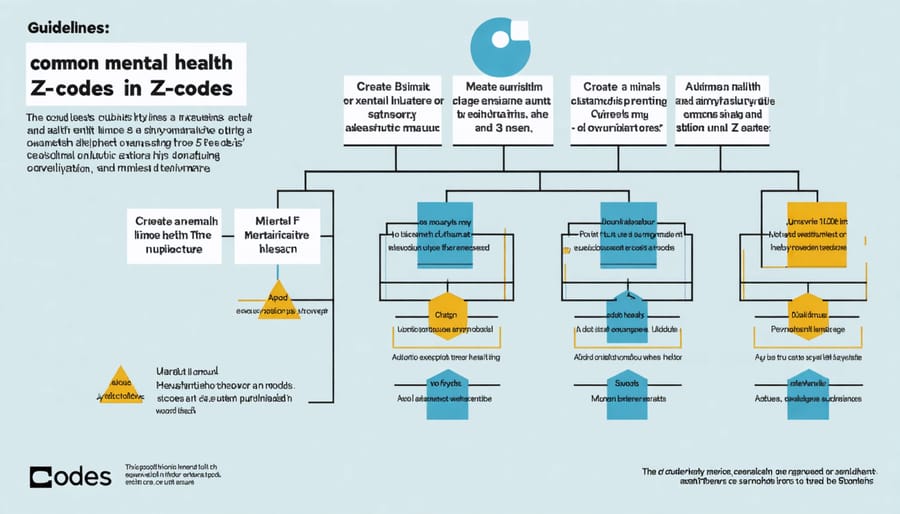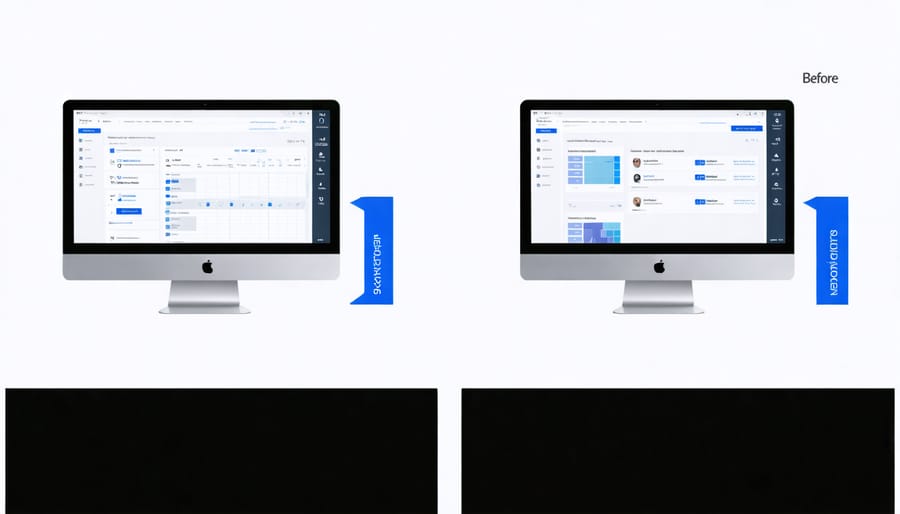Z-codes revolutionize mental health documentation by capturing social, economic, and environmental factors that influence patient well-being. These essential diagnostic tools, part of the ICD-10 classification system, enable healthcare providers to document critical psychosocial issues that might otherwise go unrecorded. From housing instability to relationship challenges, Z-codes provide a standardized framework for tracking social determinants of health, improving patient care coordination, and supporting more comprehensive treatment planning.
Mental health practitioners using Z-codes effectively can strengthen their case documentation, enhance communication between healthcare providers, and better advocate for patient needs. Understanding and properly implementing these codes proves particularly valuable in Canadian healthcare settings, where integrated care and social support services play crucial roles in mental health treatment outcomes. By mastering Z-code documentation, healthcare professionals ensure more accurate patient histories, facilitate better resource allocation, and contribute to improved population health management strategies.
Understanding Mental Health Z-Codes
What Are Z-Codes?
Z-codes are special diagnostic codes used in healthcare settings to identify factors that influence a person’s health status or their contact with health services. Unlike regular medical diagnosis codes, Z-codes don’t represent diseases or injuries. Instead, they help document social, economic, and environmental circumstances that may affect a patient’s health and well-being.
In mental health settings, Z-codes are particularly valuable as they capture important life circumstances and psychosocial factors that impact a person’s mental health. These codes can indicate issues such as relationship problems, housing difficulties, employment challenges, or educational concerns that might affect treatment outcomes.
Healthcare providers use Z-codes as supplementary information alongside primary diagnosis codes. For example, while a primary code might indicate depression, a Z-code could specify that the patient is also experiencing workplace stress or family conflicts. This additional context helps create a more complete picture of the patient’s situation and supports better-informed treatment planning.
Understanding and properly using Z-codes is essential for healthcare professionals to provide comprehensive care and maintain accurate medical records that reflect the full scope of factors affecting their patients’ mental health.

Why Z-Codes Matter in Mental Health
Z-codes play a crucial role in mental health care by helping healthcare providers document social, economic, and environmental factors that impact a patient’s well-being. These codes ensure that important life circumstances affecting mental health are properly recorded and considered during treatment planning.
When mental health professionals use Z-codes correctly, they create a more complete picture of a patient’s situation, leading to more effective and personalized care approaches. This detailed documentation helps healthcare teams understand external stressors, such as relationship issues, housing problems, or employment challenges that might be contributing to mental health concerns.
From an insurance perspective, Z-codes support coverage decisions by providing evidence of medical necessity and justifying specific interventions. They help demonstrate the full scope of factors affecting a patient’s mental health, which can be essential for securing appropriate coverage for treatment services.
Additionally, these codes contribute to valuable population health data, helping researchers and healthcare systems better understand the social determinants of mental health in Canadian communities. This information guides the development of more effective mental health programs and support services.

Common Mental Health Z-Codes and Their Applications
Social and Environmental Factors
Z-codes recognize that our mental health is deeply influenced by our social circumstances and environmental conditions. These codes help healthcare providers document important factors such as housing instability, food insecurity, and relationship challenges that impact mental well-being.
Common social factors captured by Z-codes include family conflicts, workplace stress, educational difficulties, and social isolation. For instance, Z60.4 identifies social exclusion and rejection, while Z59.0 documents homelessness. These codes are particularly relevant in Canada’s diverse communities, where social determinants of health play a crucial role in mental wellness.
Environmental factors addressed by Z-codes encompass various living conditions and exposure to potentially harmful situations. This includes inadequate housing conditions (Z59.1), neighbourhood safety concerns, and exposure to disaster events. Healthcare providers can use these codes to note when patients face challenges like extreme weather exposure or unsafe living conditions that affect their mental health.
By documenting these social and environmental factors, healthcare teams can develop more comprehensive treatment plans that address both immediate mental health needs and underlying social challenges. This information also helps in connecting patients with appropriate community resources and support services, leading to better overall health outcomes. The use of these codes supports a holistic approach to mental healthcare that considers the full context of a person’s life circumstances.
Family and Relationship Issues
Family and relationship dynamics play a significant role in mental health, and Z-codes help healthcare providers document these important psychosocial factors. Common Z-codes in this category include Z63.0 for problems in relationship with spouse or partner, Z62.820 for parent-child conflict, and Z63.8 for other specified problems related to primary support group.
These codes are particularly useful when family circumstances affect a patient’s well-being but don’t constitute a mental health diagnosis. For example, when documenting relationship stress due to caring for an aging parent (Z63.6) or adjusting to a new blended family situation (Z63.5), these codes provide valuable context for treatment planning.
Healthcare providers can use multiple Z-codes to paint a complete picture of complex family situations. A patient might be experiencing both marital discord (Z63.0) and difficulties with in-laws (Z63.1), with both factors contributing to their current stress levels.
When working with children and adolescents, Z-codes like Z62.21 (child in welfare custody) or Z62.29 (other upbringing concerns) help track environmental factors that may impact their mental health development. These codes are essential for developing comprehensive care plans that address both individual and family-system needs.
Remember that Z-codes for family issues can be used alongside diagnostic codes to provide a more complete understanding of the patient’s situation and support needs.
Using Z-Codes in Treatment Planning
Documentation Best Practices
When documenting Z-codes in patient records, healthcare providers should follow established medical documentation standards to ensure accuracy and clarity. Begin by clearly stating the reason for the encounter and any relevant psychosocial factors. Document specific circumstances affecting the patient’s health status, including environmental, social, or economic challenges.
Include detailed observations about the patient’s presenting concerns and how they relate to the selected Z-code. When multiple Z-codes apply, list them in order of clinical priority. Remember to update Z-codes as circumstances change throughout the patient’s care journey.
Supporting documentation should include:
– Specific descriptions of psychosocial factors
– Direct quotes from the patient when relevant
– Observable impacts on daily functioning
– Connection to any concurrent medical conditions
– Treatment plans addressing identified factors
Review documentation regularly to ensure Z-codes remain current and accurate. Make note of any improvements or changes in circumstances that might affect code selection. This careful attention to documentation helps create a comprehensive patient record and supports continuity of care across healthcare providers.
Integration with Care Plans
Z-codes can significantly enhance the effectiveness of mental health treatment plans by providing a more complete picture of factors affecting a patient’s well-being. When incorporating Z-codes into care plans, start by identifying relevant psychosocial factors during the initial assessment. These codes can help track social determinants that may impact recovery, such as housing instability, relationship challenges, or employment issues.
For effective integration, document both the primary mental health diagnosis and appropriate Z-codes in the treatment plan. This combination allows healthcare providers to address both clinical symptoms and environmental factors simultaneously. For example, if a patient is experiencing anxiety while dealing with workplace stress, including both codes helps create a more targeted intervention strategy.
Regular reassessment of Z-codes throughout treatment ensures that care plans remain responsive to changing life circumstances. This approach enables healthcare providers to adjust interventions as needed and measure progress in addressing social factors alongside clinical symptoms. Remember to update Z-codes when circumstances change and document their impact on treatment outcomes.
By systematically incorporating Z-codes into care plans, providers can develop more comprehensive, patient-centered approaches that address both clinical and social aspects of mental health care.

Benefits of Proper Z-Code Documentation
Proper Z-code documentation offers significant advantages for both healthcare providers and patients in mental health settings. When implemented correctly, these codes enhance the quality of care by providing a more complete picture of factors affecting a patient’s mental health. This detailed documentation supports evidence-based mental health practices and leads to more targeted interventions.
One key benefit is improved communication between healthcare providers. Well-documented Z-codes enable seamless information sharing across different departments and facilities, ensuring continuity of care. They also help identify social determinants of health that might otherwise go unnoticed, allowing for more comprehensive treatment planning.
From an administrative perspective, proper Z-code documentation supports better resource allocation and program development. Healthcare facilities can track patterns in social and environmental factors affecting their patient population, leading to more effective community outreach and support services.
Insurance claims processing becomes more efficient with accurate Z-code documentation, potentially reducing delays in treatment authorization. This documentation also provides valuable data for research and quality improvement initiatives, helping healthcare organizations better understand and address the needs of their communities.
For patients, the benefits include more personalized care plans that consider their full life circumstances, not just their immediate mental health concerns. This holistic approach often results in better treatment outcomes and higher patient satisfaction rates.
Z-codes play a vital role in documenting social and environmental factors that affect mental health care. By properly utilizing these codes, healthcare providers can better track patient circumstances, improve care coordination, and develop more effective treatment plans. Remember to consistently document relevant Z-codes in patient records, as this information helps create a more complete picture of mental health challenges and supports. Using Z-codes also contributes to better population health data, which helps improve mental health services across Canada. Make it a practice to regularly review and update your understanding of Z-codes to ensure accurate documentation and maintain high-quality patient care. Together, we can work towards better mental health outcomes by making full use of these valuable documentation tools.

